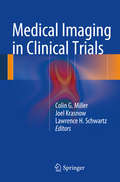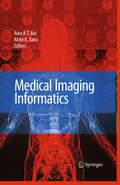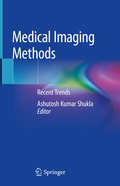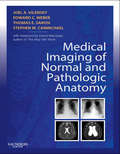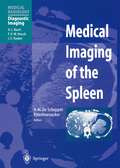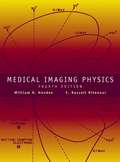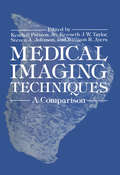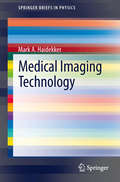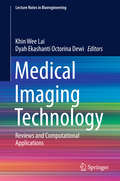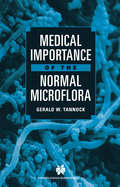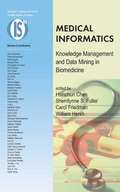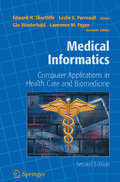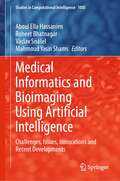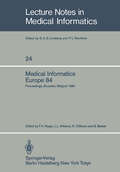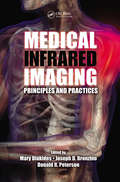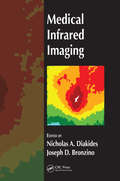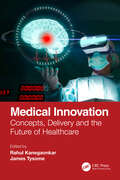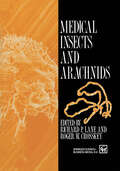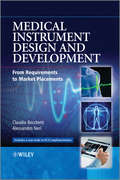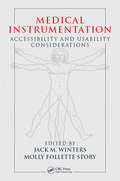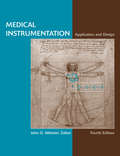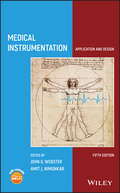- Table View
- List View
Medical Imaging in Clinical Trials
by Colin G. Miller Joel Krasnow Lawrence H. SchwartzIn the last few years the use of medical imaging has increased exponentially in routine clinical practice. This has been reflected in a rapidly increasing use of medical imaging in clinical trials, through all phases. More recently this has culminated in a number of inter-disciplinary meetings with the various stake holders, including the FDA. Changes in the regulatory process has resulted, when it comes to the submission of data to the FDA, in a therapeutic agent where one or more of the trial end-points is the assessment of a radiological end-point. No longer is it sufficient to have the images read by the local investigator site.The FDA has also identified Medical Imaging as one of the key 6 points in the Critical Path initiative which was launched in 2004. This puts a keen focus on the role of imaging and the need to clearly identify and understand this aspect of clinical trials.As the pharmaceutical, biotech and medical device industry continues to identify ways to improve and speed up product development, medical imaging plays a more significant role. An understanding of the methodology and the metrics is therefore required but difficult to ascertain in one easy to read volume for individuals entering this field. This book will therefore fulfill this void, be it for the pharmaceutical personnel from medical director to monitor, or the Principal Investigator who is having to understand the complexities of the imaging and why it is having to be sent off-site for a 'central read.'
Medical Imaging Informatics
by Alex A.T. Bui Ricky K. TairaMedical Imaging Informatics provides an overview of this growing discipline, which stems from an intersection of biomedical informatics, medical imaging, computer science and medicine. Supporting two complementary views, this volume explores the fundamental technologies and algorithms that comprise this field, as well as the application of medical imaging informatics to subsequently improve healthcare research. Clearly written in a four part structure, this introduction follows natural healthcare processes, illustrating the roles of data collection and standardization, context extraction and modeling, and medical decision making tools and applications. Medical Imaging Informatics identifies core concepts within the field, explores research challenges that drive development, and includes current state-of-the-art methods and strategies.
Medical Imaging Methods: Recent Trends
by Ashutosh Kumar ShuklaThis book provides insights into current radiology practices in diagnostic imaging, discussing specific features of individual imaging techniques, such as sensitivity, specificity and accuracy and signal-to-noise ratio. It includes chapters on various established imaging methods as well as emerging methods such as EPR imaging, and their applications in the diagnosis of skin cancer, brain tumors, oral diseases and kidney cysts. Adopting a bottom-up approach and presenting the recent trends in a simple manner with the help of examples, the book appeals to a wide audience, including academics, researchers, medical and nursing students, as well as healthcare professionals in the field of imaging and radiology.
Medical Imaging of Normal and Pathologic Anatomy E-Book
by Joel A. Vilensky Edward C. Weber Stephen W. Carmichael Thomas SarosiWritten for the modern medical student and designed to accompany any current gross anatomy textbook, this brand-new pictorial handbook presented by Drs. Vilensky, Weber, Carmichael, and Sarosi lets you quickly identify pathologic correlates of gross anatomy. Abundant side-by-side high-quality radiography, MR, CT, and ultrasound images of normal and pathologic conditions help you quickly develop the skills you need to differentiate between what’s normal and what’s not. Discussions on the choice of imaging modality for various pathologies will help you select the right imaging procedure in many clinical situations, making this a handy resource in the clinical environment. But best of all, this visual approach to pathologic correlates will help you ace your courses, the USMLE and NBME final exams.• Features side-by-side radiography, MR, CT, and ultrasound images that illustrate normal and abnormal anatomy, helping you quickly identify conditions while improving your diagnostic skills. • Covers clinical conditions found in the main core of textbooks and radiologically depicts the clinical correlates that you’re exposed to daily, making it the ideal companion resource for any medical gross anatomy course. • Uses concise, brief text that explains the condition, thus allowing the radiologic images to guide you to the differentiating factors. • Incorporates discussions of imaging modality choices for a range of pathologies to help you understand how to select imaging procedures for various clinical situations in the clinical environment. • Offers the visual guidance you need to study for and pass your exams.
Medical Imaging of the Spleen (Medical Radiology)
by FilipVanhoenacker Arthur M. SchepperProviding a much-needed update on imaging of the spleen, introductory chapters discuss the normal anatomy and radiological appearances. Then, individual chapters document the imaging findings in a wide range of hematological, immunological, oncological, infectious, vascular, and systemic disorders. Splenic pathology in infancy and childhood is considered separately, and there is a chapter on interventional procedures. Informative differential diagnostic tables are also provided. This well-illustrated book will serve as an invaluable source of easily accessible information for both clinicians and radiologists.
Medical Imaging Physics
by William R. Hendee E. Russell RitenourThis comprehensive publication covers all aspects of image formation in modern medical imaging modalities, from radiography, fluoroscopy, and computed tomography, to magnetic resonance imaging and ultrasound. It addresses the techniques and instrumentation used in the rapidly changing field of medical imaging. Now in its fourth edition, this text provides the reader with the tools necessary to be comfortable with the physical principles, equipment, and procedures used in diagnostic imaging, as well as appreciate the capabilities and limitations of the technologies.
Medical Imaging Technology (SpringerBriefs in Physics)
by Mark A HaidekkerBiomedical imaging is a relatively young discipline that started with Conrad Wilhelm Roentgen’s discovery of the x-ray in 1895. X-ray imaging was rapidly adopted in hospitals around the world. However, it was the advent of computerized data and image processing that made revolutionary new imaging modalities possible. Today, cross-sections and three-dimensional reconstructions of the organs inside the human body is possible with unprecedented speed, detail and quality. This book provides an introduction into the principles of image formation of key medical imaging modalities: X-ray projection imaging, x-ray computed tomography, magnetic resonance imaging, ultrasound imaging, and radionuclide imaging. Recent developments in optical imaging are also covered. For each imaging modality, the introduction into the physical principles and sources of contrast is provided, followed by the methods of image formation, engineering aspects of the imaging devices, and a discussion of strengths and limitations of the modality. With this book, the reader gains a broad foundation of understanding and knowledge how today’s medical imaging devices operate. In addition, the chapters in this book can serve as an entry point for the in-depth study of individual modalities by providing the essential basics of each modality in a comprehensive and easy-to-understand manner. As such, this book is equally attractive as a textbook for undergraduate or graduate biomedical imaging classes and as a reference and self-study guide for more specialized in-depth studies.
Medical Imaging Technology: Reviews and Computational Applications (Lecture Notes in Bioengineering)
by Khin Wee Lai Dyah Ekashanti Octorina DewiThis book presents the latest research findings and reviews in the field of medical imaging technology, covering ultrasound diagnostics approaches for detecting osteoarthritis, breast carcinoma and cardiovascular conditions, image guided biopsy and segmentation techniques for detecting lung cancer, image fusion, and simulating fluid flows for cardiovascular applications. It offers a useful guide for students, lecturers and professional researchers in the fields of biomedical engineering and image processing.
Medical Importance of the Normal Microflora
by Gerald W. TannockIt has been estimated that there are more microbial cells inhabiting the human body than there are eukaryotic cells of which it is made up. This normal microflora usually co-exists relatively peacefully with the host and does not cause infection. The mechanisms by which this co-existence is achieved are still not properly understood and the interaction between the normal microflora and the host is far from simple. For a variety of reasons, however, this interaction can be disturbed and often results in the microflora becoming pathogens. The study of the diseases then caused is important both in terms of treatment and in terms of contributing to our understanding of the mechanisms by which the normal microflora usually interacts with the host. This title brings together an international list of contributors, all of whom have active research interests in the normal microflora. Each of the chapters reviews current knowledge about a specific group or organism within the microflora and the diseases they can cause. Microflora of the skin, respiratory tract, oral cavity, gastrointestinal system and genital tract are all discussed and the impact of molecular methods on our understanding of the normal microflora is emphasised throughout the book. Medical microbiologists, dental specialists, infectious disease specialists, nutritionists and gastroenterologists will all find this book of immense interest and value, as will epidemiologists, dermatologists and general microbiologists.
Medical Informatics: Knowledge Management and Data Mining in Biomedicine (Integrated Series in Information Systems #8)
by Hsinchun Chen Carol Friedman Sherrilynne S. Fuller William HershComprehensively presents the foundations and leading application research in medical informatics/biomedicine. The concepts and techniques are illustrated with detailed case studies. Authors are widely recognized professors and researchers in Schools of Medicine and Information Systems from the University of Arizona, University of Washington, Columbia University, and Oregon Health & Science University. Related Springer title, Shortliffe: Medical Informatics, has sold over 8000 copies The title will be positioned at the upper division and graduate level Medical Informatics course and a reference work for practitioners in the field.
Medical Informatics: Computer Applications in Health Care and Biomedicine (Health Informatics)
by G. Wiederhold L. M. FaganThe practice of modern medicine requires sophisticated information technologies with which to manage patient information, plan diagnostic procedures, interpret laboratory results, and conduct research. Designed for a broad audience, this book fills the need for a high quality reference in computers and medicine, first explaining basic concepts, then illustrating them with specific systems and technologies. Medical Informatics provides both a conceptual framework and a practical inspiration for this swiftly emerging scientific discipline. The second edition covers system design and engineering, ethics of health informatics, system evaluation and technology assessment, public health and consumer use of health information, and healthcare financing.
Medical Informatics and Bioimaging Using Artificial Intelligence: Challenges, Issues, Innovations and Recent Developments (Studies in Computational Intelligence #1005)
by Aboul Ella Hassanien Roheet Bhatnagar Václav Snášel Mahmoud Yasin ShamsThis book emphasizes the latest developments and achievements in artificial intelligence and related technologies, focusing on the applications of artificial intelligence and medical diagnosis. The book describes the theory, applications, concept visualization, and critical surveys covering most aspects of AI for medical informatics.
Medical Informatics Europe 84: Proceedings, Brussels, Belgium, September 10–13, 1984 (Lecture Notes in Medical Informatics #24)
by F. H. Roger J. L. Willems R. O'Moore B. BarberMedical Infrared Imaging: Principles and Practices
by Mary Diakides Joseph D. Bronzino Donald R. PetersonThe evolution of technological advances in infrared sensor technology, image processing, "smart" algorithms, knowledge-based databases, and their overall system integration has resulted in new methods of research and use in medical infrared imaging. The development of infrared cameras with focal plane arrays no longer requiring cooling, added a new
Medical Infrared Imaging
by Nicholas A. Diakides Joseph D. BronzinoRapid evolution of technical advances in infrared sensor technology, image processing, ‘smart algorithms, databases, and system integration paves the way for new methods of research and use in medical infrared imaging. These breakthroughs permit easy-to-use, high-sensitivity imaging that can address key issues of diagnostic specificity and engende
Medical Innovation: Concepts, Delivery and the Future of Healthcare
by Rahul Kanegaonkar James TysomeAn essential text for innovators, this accessible book explains how medical and healthcare professionals and students who are new to innovation in healthcare can best progress their innovation projects and how those interested in healthcare innovation can develop an improved understanding of novel treatments and developments. The book provides a clear framework for the innovation pathway, describing step-by-step how projects are taken from concept to marketing, and also includes a current assessment of emerging technologies that will influence medical innovation in the future. Key Features: Wide-ranging and comprehensive coverage of the field, from digital health and AI technologies, through stem-cell applications and robotic surgery, to specialty-specific innovations including those in cardiology, public health and ophthalmology Illustrated with real-life examples of success and failure and what can be learned from these projects Reflects a greater emphasis on clinical innovation within health systems and its inclusion in undergraduate and postgraduate medical curriculae and medically related courses Supports national and international initiatives to encourage innovation in healthcare and maximize the novel ideas generated by university staff and students, as well as practicing clinicians Ideal for students at both undergraduate and postgraduate level and medical practitioners and allied medical health professionals, it will also be of interest to clinical innovators and healthcare businesses seeking to increase uptake of their products both in the UK and internationally.
Medical Innovation: Concepts, Delivery and the Future of Healthcare
by Rahul Kanegaonkar James TysomeAn essential text for innovators, this accessible book explains how medical and healthcare professionals and students who are new to innovation in healthcare can best progress their innovation projects and how those interested in healthcare innovation can develop an improved understanding of novel treatments and developments. The book provides a clear framework for the innovation pathway, describing step-by-step how projects are taken from concept to marketing, and also includes a current assessment of emerging technologies that will influence medical innovation in the future. Key Features: Wide-ranging and comprehensive coverage of the field, from digital health and AI technologies, through stem-cell applications and robotic surgery, to specialty-specific innovations including those in cardiology, public health and ophthalmology Illustrated with real-life examples of success and failure and what can be learned from these projects Reflects a greater emphasis on clinical innovation within health systems and its inclusion in undergraduate and postgraduate medical curriculae and medically related courses Supports national and international initiatives to encourage innovation in healthcare and maximize the novel ideas generated by university staff and students, as well as practicing clinicians Ideal for students at both undergraduate and postgraduate level and medical practitioners and allied medical health professionals, it will also be of interest to clinical innovators and healthcare businesses seeking to increase uptake of their products both in the UK and internationally.
Medical Insects and Arachnids
by R.P. Lane R.W. CrosskeySurprising though it seems, the world faces almost as great a threat today from arthropod-borne diseases as it did in the heady days of the 1950s when global eradication of such diseases by eliminating their vectors with synthetic insecticides, particularly DDT, seemed a real possibility. Malaria, for example, still causes tremendous morbidity and mortality throughout the world, especially in Africa. Knowledge of the biology of insect and arachnid disease vectors is arguably more important now than it has ever been. Biological research directed at the development of better methods of control becomes even more important in the light of the partial failure of many control schemes that are based on insecticide- although not all is gloom, since basic biological studies have contributed enormously to the outstanding success of international control programmes such as the vast Onchocerciasis Control Programme in West Africa. It is a sine qua non for proper understanding of the epidemiology and successful vector control of any human disease transmitted by an arthropod that all concerned with the problem - medical entomologist, parasitologist, field technician - have a good basic understanding of the arthropod's biology. Knowledge will be needed not only of its direct relationship to any parasite or pathogen that it transmits but also of its structure, its life history and its behaviour - in short, its natural history. Above all, it will be necessary to be sure that it is correctly identified.
Medical Instrument Design and Development: From Requirements to Market Placements
by Claudio Becchetti Alessandro NeriThis book explains all of the stages involved in developing medical devices; from concept to medical approval including system engineering, bioinstrumentation design, signal processing, electronics, software and ICT with Cloud and e-Health development. Medical Instrument Design and Development offers a comprehensive theoretical background with extensive use of diagrams, graphics and tables (around 400 throughout the book). The book explains how the theory is translated into industrial medical products using a market-sold Electrocardiograph disclosed in its design by the Gamma Cardio Soft manufacturer. The sequence of the chapters reflects the product development lifecycle. Each chapter is focused on a specific University course and is divided into two sections: theory and implementation. The theory sections explain the main concepts and principles which remain valid across technological evolutions of medical instrumentation. The Implementation sections show how the theory is translated into a medical product. The Electrocardiograph (ECG or EKG) is used as an example as it is a suitable device to explore to fully understand medical instrumentation since it is sufficiently simple but encompasses all the main areas involved in developing medical electronic equipment. Key Features: Introduces a system-level approach to product design Covers topics such as bioinstrumentation, signal processing, information theory, electronics, software, firmware, telemedicine, e-Health and medical device certification Explains how to use theory to implement a market product (using ECG as an example) Examines the design and applications of main medical instruments Details the additional know-how required for product implementation: business context, system design, project management, intellectual property rights, product life cycle, etc. Includes an accompanying website with the design of the certified ECG product (www.gammacardiosoft.it/book) Discloses the details of a marketed ECG Product (from Gamma Cardio Soft) compliant with the ANSI standard AAMI EC 11 under open licenses (GNU GPL, Creative Common) This book is written for biomedical engineering courses (upper-level undergraduate and graduate students) and for engineers interested in medical instrumentation/device design with a comprehensive and interdisciplinary system perspective.
Medical Instrument Design and Development: From Requirements to Market Placements
by Claudio Becchetti Alessandro NeriThis book explains all of the stages involved in developing medical devices; from concept to medical approval including system engineering, bioinstrumentation design, signal processing, electronics, software and ICT with Cloud and e-Health development. Medical Instrument Design and Development offers a comprehensive theoretical background with extensive use of diagrams, graphics and tables (around 400 throughout the book). The book explains how the theory is translated into industrial medical products using a market-sold Electrocardiograph disclosed in its design by the Gamma Cardio Soft manufacturer. The sequence of the chapters reflects the product development lifecycle. Each chapter is focused on a specific University course and is divided into two sections: theory and implementation. The theory sections explain the main concepts and principles which remain valid across technological evolutions of medical instrumentation. The Implementation sections show how the theory is translated into a medical product. The Electrocardiograph (ECG or EKG) is used as an example as it is a suitable device to explore to fully understand medical instrumentation since it is sufficiently simple but encompasses all the main areas involved in developing medical electronic equipment. Key Features: Introduces a system-level approach to product design Covers topics such as bioinstrumentation, signal processing, information theory, electronics, software, firmware, telemedicine, e-Health and medical device certification Explains how to use theory to implement a market product (using ECG as an example) Examines the design and applications of main medical instruments Details the additional know-how required for product implementation: business context, system design, project management, intellectual property rights, product life cycle, etc. Includes an accompanying website with the design of the certified ECG product (www.gammacardiosoft.it/book) Discloses the details of a marketed ECG Product (from Gamma Cardio Soft) compliant with the ANSI standard AAMI EC 11 under open licenses (GNU GPL, Creative Common) This book is written for biomedical engineering courses (upper-level undergraduate and graduate students) and for engineers interested in medical instrumentation/device design with a comprehensive and interdisciplinary system perspective.
Medical Instrumentation: Accessibility and Usability Considerations
by Molly Follette Story Jack M. WintersTwo of the most important yet often overlooked aspects of a medical device are its usability and accessibility. This is important not only for health care providers, but also for older patients and users with disabilities or activity limitations. Medical Instrumentation: Accessibility and Usability Considerations focuses on how lack of usabi
Medical Instrumentation: Application and Design
by John G. WebsterThis contributed book provides the premiere reference on medical instrumentation as well as a comprehensive overview of the basic concepts of medical instrumentation illustrating the interdisciplinary nature of bioinstrumentation. This revised edition features new material on infant apnea monitors, impedance pneumography, the design of cardiac pacemakers, and disposable defibrillator electrodes and their standards.
Medical Instrumentation: Application and Design
by John G. Webster Amit J. NimunkarProvides a comprehensive overview of the basic concepts behind the application and designs of medical instrumentation This premiere reference on medical instrumentation describes the principles, applications, and design of the medical instrumentation most commonly used in hospitals. It places great emphasis on design principles so that scientists with limited background in electronics can gain enough information to design instruments that may not be commercially available. The revised edition includes new material on microcontroller-based medical instrumentation with relevant code, device design with circuit simulations and implementations, dry electrodes for electrocardiography, sleep apnea monitor, Infusion pump system, medical imaging techniques and electrical safety. Each chapter includes new problems and updated reference material that covers the latest medical technologies. Medical Instrumentation: Application and Design, Fifth Edition covers general concepts that are applicable to all instrumentation systems, including the static and dynamic characteristics of a system, the engineering design process, the commercial development and regulatory classifications, and the electrical safety, protection, codes and standards for medical devices. The readers learn about the principles behind various sensor mechanisms, the necessary amplifier and filter designs for analog signal processing, and the digital data acquisition, processing, storage and display using microcontrollers. The measurements of both cardiovascular dynamics and respiratory dynamics are discussed, as is the developing field of biosensors. The book also covers general concepts of clinical laboratory instrumentation, medical imaging, various therapeutic and prosthetic devices, and more. Emphasizes design throughout so scientists and engineers can create medical instruments Updates the coverage of modern sensor signal processing New material added to the chapter on modern microcontroller use Features revised chapters, descriptions, and references throughout Includes many new worked out examples and supports student problem-solving Offers updated, new, and expanded materials on a companion webpage Supplemented with a solutions manual containing complete solutions to all problems Medical Instrumentation: Application and Design, Fifth Edition is an excellent book for a senior to graduate-level course in biomedical engineering and will benefit other health professionals involved with the topic.
Medical Instrumentation: Application and Design
by John G. Webster Amit J. NimunkarProvides a comprehensive overview of the basic concepts behind the application and designs of medical instrumentation This premiere reference on medical instrumentation describes the principles, applications, and design of the medical instrumentation most commonly used in hospitals. It places great emphasis on design principles so that scientists with limited background in electronics can gain enough information to design instruments that may not be commercially available. The revised edition includes new material on microcontroller-based medical instrumentation with relevant code, device design with circuit simulations and implementations, dry electrodes for electrocardiography, sleep apnea monitor, Infusion pump system, medical imaging techniques and electrical safety. Each chapter includes new problems and updated reference material that covers the latest medical technologies. Medical Instrumentation: Application and Design, Fifth Edition covers general concepts that are applicable to all instrumentation systems, including the static and dynamic characteristics of a system, the engineering design process, the commercial development and regulatory classifications, and the electrical safety, protection, codes and standards for medical devices. The readers learn about the principles behind various sensor mechanisms, the necessary amplifier and filter designs for analog signal processing, and the digital data acquisition, processing, storage and display using microcontrollers. The measurements of both cardiovascular dynamics and respiratory dynamics are discussed, as is the developing field of biosensors. The book also covers general concepts of clinical laboratory instrumentation, medical imaging, various therapeutic and prosthetic devices, and more. Emphasizes design throughout so scientists and engineers can create medical instruments Updates the coverage of modern sensor signal processing New material added to the chapter on modern microcontroller use Features revised chapters, descriptions, and references throughout Includes many new worked out examples and supports student problem-solving Offers updated, new, and expanded materials on a companion webpage Supplemented with a solutions manual containing complete solutions to all problems Medical Instrumentation: Application and Design, Fifth Edition is an excellent book for a senior to graduate-level course in biomedical engineering and will benefit other health professionals involved with the topic.
